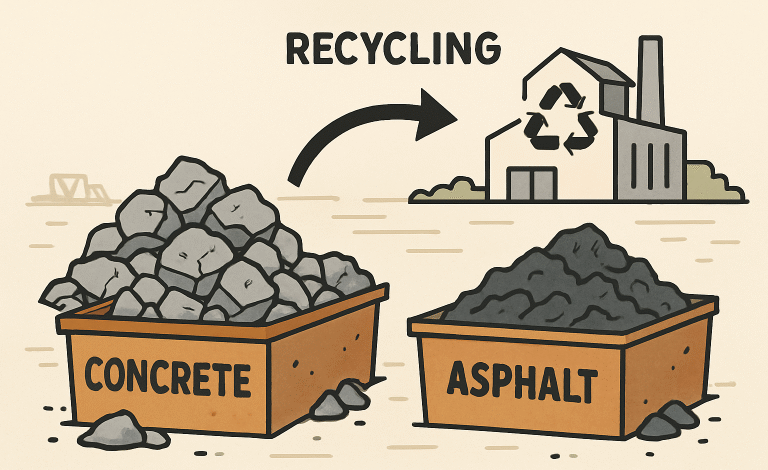Innovative Strategies For Responsible Concrete And Asphalt Disposal

Disposing of concrete and asphalt is a critical challenge in the construction and demolition industry. Each year, demolition and construction activities generate massive waste, straining resources and space at local landfills. Failing to properly sort and process these materials results in environmental hazards, increased project costs, and potential legal consequences. By making responsible choices regarding concrete disposal, contractors and property owners can help divert tons of valuable material from landfills and promote a cleaner, safer community.
Responsibly managed concrete and asphalt waste benefits everyone—from project managers aiming to cut costs to neighbors looking to avoid pollution and eyesores. Thoughtful disposal keeps harmful debris out of the landfill and ensures these durable materials find new life in future infrastructure projects or landscaping. Establishing efficient and eco-friendly methods for handling demolition debris makes good business sense and fulfills a shared obligation to the environment.
Understanding What Can Be Recycled
Many people overlook the recyclability of construction materials, but clean, uncontaminated concrete and asphalt are among the most straightforward items to recover. Unmixed concrete, free from intermingled materials like rebar, plastic, or wood, can be crushed and processed into aggregate for reuse in new projects. Similarly, pure asphalt pavement can be reclaimed and integrated into new paving mixes. When concrete is mixed with foreign materials, the recycling process becomes more complex, yet there are growing programs tailored to manage these mixed loads. The EPA’s construction and demolition recycling guidelines offer valuable direction for identifying recyclable materials and distinguishing what must go to a landfill.
Sorting and Preparing Materials for Disposal
Efficient recycling begins with diligent sorting at the job site. Separating concrete and asphalt from other construction debris ensures the cleanest, most valuable recyclables are delivered to processing facilities. Follow these essential preparation steps to maximize recycling success:
- Set up distinct containers or dumpsters for concrete and asphalt waste, away from general debris.
- Remove embedded materials such as rebar, piping, or wooden forms before placing debris in recycling bins.
- Mark all containers to avoid accidental mixing or contamination.
Streamlined procedures at the source prevent confusion among workers and save money by reducing contamination-related fees. For those planning large-scale demolitions, consulting with specialized recycling facilities in advance ensures your waste management plan aligns with local regulations and operational capabilities. Working with knowledgeable partners prevents costly missteps and establishes a routine for regular site pickups, minimizing clutter and hazards.
Environmental Benefits of Recycling
The environmental impact of recycling concrete and asphalt extends far beyond landfill diversion. Recycled construction materials save finite resources like sand, gravel, and water, which are frequently overexploited in new construction projects. They also help reduce greenhouse gas emissions linked to quarrying and long-distance transportation of virgin materials. A New York Times article highlights how recycling can dramatically lower the carbon footprint of urban infrastructure by meeting demand with reclaimed aggregates.
Beyond emissions and resource conservation, using recycled aggregates in new construction supports a more circular economic model where waste is seen as a crucial feedstock rather than an afterthought. This sustainable approach helps communities build greener, more resilient infrastructure while keeping long-term costs in check.
Regulations and Best Practices
Increasingly, cities and states are introducing ordinances mandating recycling key construction materials. Noncompliance can result in substantial fines and possible project stoppages. Staying current on local and regional requirements is essential—many jurisdictions publish lists of approved recycling centers and waste haulers to make compliance easier. It is best practice to work only with licensed, reputable waste management services to guarantee materials are handled according to regulations and environmental standards.
Routine staff education and training ensure field crews understand best practices for sorting, handling, and documenting recyclable construction waste. Maintaining transparent records is beneficial for regulatory compliance, optimizing internal reporting, and measuring the impact of sustainability initiatives.
Innovative Uses for Recycled Materials
The realm of recycled concrete and asphalt continues to expand, fueling innovation across the construction industry. Recycled concrete aggregate (RCA) is commonly used in new road bases, driveways, walkways, parking lots, and even eco-smart landscaping projects. As for asphalt, reclaimed material can be re-blended with fresh binder and used for highways, bike paths, and playground surfaces, often performing as well as virgin materials at a lower cost. According to For Construction Pros, innovative approaches are helping contractors reduce costs while supporting ambitious green building targets.
Steps to Improve Your Construction Waste Process
- Conduct a comprehensive audit of your current waste streams to identify untapped recycling opportunities.
- Educate employees and subcontractors on proper sorting, contamination avoidance, and recycling procedures.
- Establish a clear collection and pickup schedule with recycling partners to prevent accumulation and cross-contamination.
- Track the volume and types of recycled materials for project management and reporting to local authorities.
- Reinvest savings from reduced landfill fees by adopting further environmental improvements in future projects.
Community and Industry Collaboration
Across the country, community and industry partnerships are helping to redefine construction waste management. Public-private collaborations often lead to higher recycling rates and more robust infrastructure for processing construction debris. Municipalities that engage with local businesses and industry groups more effectively drive compliance, waste diversion improvements, and building practices innovation. Sharing examples and data on successful recycling initiatives can inspire neighboring cities and companies to adopt similar, forward-thinking policies.
Conclusion
Responsible concrete and asphalt disposal is critical for cost effectiveness, regulatory adherence, and environmental stewardship. By embracing modern recycling strategies and best practices, homeowners, contractors, and municipal leaders can transform construction waste from a costly burden into a valuable resource. Simple steps, ongoing education, and community engagement contribute to a future where building, demolishing, and reusing are in harmony with sustainability and progress.



